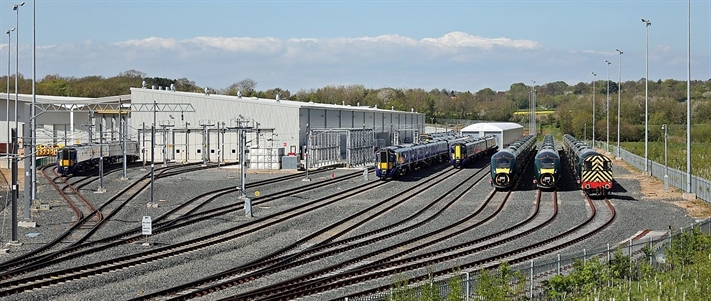Rail Industry

News Mediarail.be
The author:
Frédéric de Kemmeter
Railway signalling systems. I'm a rail observer for over 30 years. How has the railway evolved over the decades? Which futur for railways? That's what I'm analyzing and explaining.
Railway signalling systems. I'm a rail observer for over 30 years. How has the railway evolved over the decades? Which futur for railways? That's what I'm analyzing and explaining.

See also:
• My photos on Piwigo gallery
• My YouTube channel
• My blog with latest news
• Follow me on Twitter and LinkedIn
• My photos on Piwigo gallery
• My YouTube channel
• My blog with latest news
• Follow me on Twitter and LinkedIn
Hitachi Rail factory at Newton Aycliffe (photo "The joy of all things" via wikipedia)
According Unife, railway industry in Europe supplying nearly half of the global demand for rail products and employing over 400 000 people in the EU, the European rail supply industry is a strategic and innovative industry for Europe. Research and innovation (R&I) is not only essential to overcome the competitive challenges from the industry, but also to ensure that the rail sector remains attractive to passengers and end users and that it is able to increase its modal share in the face of increasingly innovative road and air modes. The European rail supply industry invests approximately 3.6% of its annual turnover in R&I, and this includes a significant contribution from the growing segment of small and medium sized rail supply companies (SMEs).
National norms
Although there was an international organisation - UIC -, born in 1921 to promote the crossing of wagons from one border to another, the initial objective was obviously not Europe, at a time when geopolitics was very much troubled by the two wars first half of the 20th century. The UIC did try to standardise what it was possible, but was limited to the profil of the wagons, the gauge of the rails and a few electrical and mechanical details, such as the brakes, the height of the buffers or the maximum length of the passenger carriages. It was not possible to unify the automatic coupling for freight cars, but well for trainsets! The railway locomotives industry remained confined to strictly national area until the conversion of different currents within a locomotive, benefiting from the best technologies, could then be used on both sides of the borders, with a few tricks that have now become classics.
Enlarge the market: on the road of standardisation
This has often been heard: the interests of the industry do not always correspond with the agenda of politicians, states and the railway networks themselves. The railway industry - like all industries - requires consistency and cannot comply with the 'stop and go' imposed by government budgetary constraints. In line with the trend towards liberalization of national markets which began in the 1980s, the rail industry was very quickly in favour of the single market which was taking shape in the 1990s. The aim was to sell trains, trams and metros to everyone, and not just at national level.
This evolution was also timely because most national railways:
• operated trains based on technologies from the 1970s, which required inevitable renewal of rolling stock;
• did not have the resources to carry out long-term railway research on their own;
• were trying to obtain less labour-intensive rolling stock and equipments, particularly to cut costs of maintenance.
Role Reversal
At the same time, another movement was taking shape: the gradual normalization of the world. This led to the application by States of various technical standards, sometimes worldwide (ISO), which henceforth also applied to the railway sector, which was asked to comply with them and to stop to play as "a world apart". Electrical standards come to mind, for example, requiring the purchase of standardized electric cables on the market, rather than in specialized manufacture. This is how the industry turned the tide: from being a subcontractor, it became an real producer, designing and producing locomotives, signalling and offering a full range of customised equipment and new methods of track maintenance, for example. This was a good thing: the railways were in the meantime transformed for the most part into public limited companies under public law, thus becoming more responsible, autonomous companies, flanked by the role of buyer and service provider. They were now only involved in writing calls for tenders, without having to describe the chemical composition of each bolt. As the roles were reversed, the entire railway manufacturers sector was profoundly modified in the space of twenty years. It went from a myriad of national factories to large European or global groups.
Today
Today this restructured landscape now presents a handful of large groups. The key word is the specialised platform: one (or two) factories produce one type of equipment, but to measure. Thus, each group produces one type of tram on a single platform, but can modify secondary parameters such as box width and interior design. The essential elements - such as the traction chain, the motorization - are standardized, which reduces production costs and, above all, makes it possible to use common components. A tram in Berlin or Milan will therefore have identical components, but are now "customised" by operator's requirements.
The worlwide railway industry includes the following major groups:
• Integrators (supplying trains, trams and metros):
Alstom, Bombardier, CRRC, Hitachi, Siemens, Skoda, Talgo, etc.;
• Specialists (in one or the other niche: wagons, railcars, railcars, self-propelled railcars, service trains, etc.):
Astra Rail Industries, CAF, Greenbrier, Kockums Industrier, Lohr Industries, Newag, Plasser, Theurer, Stadler, Vossloh, Windhoff...
• Equipment manufacturers:
Compin, Faiveley, Knorr-Bremse, Robel, SKF, Voith, Wabtec, WBN Waggonbau Niesky...
Recent Concentration
Some examples. In 2014, Siemens acquired the signalling specialist Invensys for 2.2 billion. In the summer of 2016, China's CSR and CNR merged to create CRRC, a mastodon that weighs as much as Bombardier, Alstom and Siemens combined. Japan's Hitachi was in the process of closing the takeover of Italy's Ansaldo STS - a signalling specialist - and the manufacturer AnsaldoBreda, for an operation estimated at 1.9 billion euros. At the end of 2016, it was Wabtec Corporation that acquired the equipment manufacturer Faiveley for around €1.7 billion. After the failure of the Siemens/Alstom merger, it is now talking about the takeover of Bombardier by Alstom. Nothing was still decided in 2020.
National norms
Although there was an international organisation - UIC -, born in 1921 to promote the crossing of wagons from one border to another, the initial objective was obviously not Europe, at a time when geopolitics was very much troubled by the two wars first half of the 20th century. The UIC did try to standardise what it was possible, but was limited to the profil of the wagons, the gauge of the rails and a few electrical and mechanical details, such as the brakes, the height of the buffers or the maximum length of the passenger carriages. It was not possible to unify the automatic coupling for freight cars, but well for trainsets! The railway locomotives industry remained confined to strictly national area until the conversion of different currents within a locomotive, benefiting from the best technologies, could then be used on both sides of the borders, with a few tricks that have now become classics.
Enlarge the market: on the road of standardisation
This has often been heard: the interests of the industry do not always correspond with the agenda of politicians, states and the railway networks themselves. The railway industry - like all industries - requires consistency and cannot comply with the 'stop and go' imposed by government budgetary constraints. In line with the trend towards liberalization of national markets which began in the 1980s, the rail industry was very quickly in favour of the single market which was taking shape in the 1990s. The aim was to sell trains, trams and metros to everyone, and not just at national level.
This evolution was also timely because most national railways:
• operated trains based on technologies from the 1970s, which required inevitable renewal of rolling stock;
• did not have the resources to carry out long-term railway research on their own;
• were trying to obtain less labour-intensive rolling stock and equipments, particularly to cut costs of maintenance.
Role Reversal
At the same time, another movement was taking shape: the gradual normalization of the world. This led to the application by States of various technical standards, sometimes worldwide (ISO), which henceforth also applied to the railway sector, which was asked to comply with them and to stop to play as "a world apart". Electrical standards come to mind, for example, requiring the purchase of standardized electric cables on the market, rather than in specialized manufacture. This is how the industry turned the tide: from being a subcontractor, it became an real producer, designing and producing locomotives, signalling and offering a full range of customised equipment and new methods of track maintenance, for example. This was a good thing: the railways were in the meantime transformed for the most part into public limited companies under public law, thus becoming more responsible, autonomous companies, flanked by the role of buyer and service provider. They were now only involved in writing calls for tenders, without having to describe the chemical composition of each bolt. As the roles were reversed, the entire railway manufacturers sector was profoundly modified in the space of twenty years. It went from a myriad of national factories to large European or global groups.
Today
Today this restructured landscape now presents a handful of large groups. The key word is the specialised platform: one (or two) factories produce one type of equipment, but to measure. Thus, each group produces one type of tram on a single platform, but can modify secondary parameters such as box width and interior design. The essential elements - such as the traction chain, the motorization - are standardized, which reduces production costs and, above all, makes it possible to use common components. A tram in Berlin or Milan will therefore have identical components, but are now "customised" by operator's requirements.
The worlwide railway industry includes the following major groups:
• Integrators (supplying trains, trams and metros):
Alstom, Bombardier, CRRC, Hitachi, Siemens, Skoda, Talgo, etc.;
• Specialists (in one or the other niche: wagons, railcars, railcars, self-propelled railcars, service trains, etc.):
Astra Rail Industries, CAF, Greenbrier, Kockums Industrier, Lohr Industries, Newag, Plasser, Theurer, Stadler, Vossloh, Windhoff...
• Equipment manufacturers:
Compin, Faiveley, Knorr-Bremse, Robel, SKF, Voith, Wabtec, WBN Waggonbau Niesky...
Recent Concentration
Some examples. In 2014, Siemens acquired the signalling specialist Invensys for 2.2 billion. In the summer of 2016, China's CSR and CNR merged to create CRRC, a mastodon that weighs as much as Bombardier, Alstom and Siemens combined. Japan's Hitachi was in the process of closing the takeover of Italy's Ansaldo STS - a signalling specialist - and the manufacturer AnsaldoBreda, for an operation estimated at 1.9 billion euros. At the end of 2016, it was Wabtec Corporation that acquired the equipment manufacturer Faiveley for around €1.7 billion. After the failure of the Siemens/Alstom merger, it is now talking about the takeover of Bombardier by Alstom. Nothing was still decided in 2020.








-WEc780af7f81.png)


